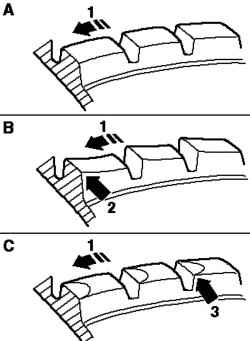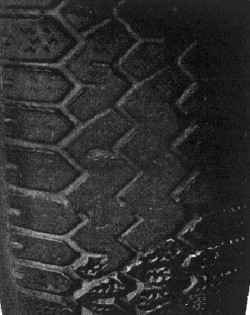 printable version printable version
Tire rolling noise
General information about the rolling noise Rolling noise perceived by the human ear - are oscillations emanating from the sound source and the air reaching the ear. It is interesting to noise created by certain features, as well as the effects of the rolling tire (noise source). The cause of most of the noise depends on the combination of tire and road surface. The surface structure and material of the roadway is also a strong influence on rolling noise. The noise level in the wet, for example, is much higher than on dry. Profiling tread greatly influences the level of noise. Tyres with transverse grooves at 90 ?° noisier than the tires with diagonal grooves. The small tread blocks are unstable. Because of their strong deformation of the rolling tire shakes the air. Creates air vibrations. which lead to noise. Wider tires noisier. For the removal of water they should have more grooves. When rolling out of these grooves displaced by air, thereby also having air vibrations. Other effects affecting the noise. "Swing tire" is a major cause of rolling noise. They arise from the excitation of the air column in the tread grooves. "Ripple air" - a compression and expansion of air when tire contact area of the tire on the road surface, which deforms when the tread blocks.
Noise tires Noise is mainly determined by the tires and the road surface. Quality of pavement affecting noise - is uneven (roughness), the structure and the material. Feedback bus parameters, among others, are the width of the tire and the disc. Wider tire due to the larger area of contact with the road surface creates more noise, because a larger volume of air is squeezed out and a large "mass" is excited into oscillation, than in a smaller size. Broader disc also increases the contact area of the tire. Thus, the influence on the noise the same as in the wide bus. In addition, wider wheels adversely affect the damping properties of the tire. Tire rolling noise heard in the car, at which the engine is installed in front of the best in the rear seats, as aerodynamic noise and the sound of the engine at this point the cabin interfere less.
Wear protector in the form of a sawtooth track Wear protector in the form of sawtooth paths - a separate step wear of the tread blocks which can lead to increased noise. Wear sawtooth occurs due to uneven deformation of the blocks of the tread surface of the tire contact with the road surface. This kind of wear often seen on the non-driven wheels than on top. New tires are more prone to tread wear sawtooth as high tread blocks more flexible. With a decrease in the depth of the tread pattern rigidity of the tread blocks increases susceptibility to this type of wear is reduced.
A - units of the new tire tread; Tread blocks when viewed in the rolling direction arrow 1, the same height in the front and rear. B - Tread Wear as a sawtooth track; Tread blocks when viewed in the rolling direction arrow 1, the front is higher than the rear needle 2. C - Power profile view of the rolling direction arrow 1 have a strong wear in front of the "tooth" arrow 3. When the tread is worn strongly expressed in the form of sawtooth track can be increased markedly noise tires. Strong tread wear a track sawtooth occurs when too much convergence wrong tire pressure with large tread blocks of the tire, mounted on wheels are not the drive axle extreme cornering.
Tyres with non-directional tread pattern Upon detection of the tread wear as a sawtooth track should change the direction of the tire rolling. If it is found reinforced tread wear as a sawtooth track and increased noise, it is necessary to rearrange the wheels crosswise. This will reduce wear and tear. On cars with front-wheel drive effectiveness of this approach will be even more noticeable due to the abrasion of tires on the front axle. Noises rolling immediately after the reshuffle wheels are a little harder, but after a run of 500-1000 km will again reach a normal level of noise.
Tyres with directional tread pattern With increased tread wear as a sawtooth track on the tires of the rear axle - primarily for front-wheel drive - rear wheel must be moved forward. When the strong deterioration of the ramp at the outer edges on the same axis, both tires should be flipped on a disk. Thereafter, the left wheel to be mounted on the right side and the left-right wheel.
Spot wear and tear due to the movement with locked wheels
| Fig. 4.12. The spots on the tread wear due to braking with locked wheels
|
This type of wear is a consequence of the strong braking with locked wheels on the area in which the tire contact with the road is cleared tread rubber (Fig. 4.12). When tire slip on the road surface friction heat is generated, which lowers the abrasion resistance of tread material. Even the most durable tread compound does not exclude the wear scar, which may occur during extreme braking. Even brake system equipped with ABS, do not exclude the latch and thus small wear. The degree of such wear significantly depends on the speed, road surface and the wheel load. For clarity, the following examples. When braking the car with locked front wheels on dry pavement to a stop tire wear on the contact area, equal to a postcard, will be: - 57 km / h = 23.8 m braking distance up to 2.0 mm; - 75 km / h = 41.8 m braking distance up to 3.3 mm; - 92 km / h = 71.6 m braking distance to 4.8 mm. Tires with similar injuries are not suitable for further use and must be replaced.
Causes of stroke harshness Reasons harshness different course. Harshness stroke can occur, including due to tire wear. During operation of the tire do not always wear evenly across the tread surface. Because of this, there is already a small imbalance that hinders the calm before rolling perfectly balanced wheel. This imbalance has not yet been felt on the steering wheel, however, is taking place. It increases the wear on the tire, and thereby reduces the service life.
NOTE To throughout the life of the tire to provide optimum safety, optimum smooth running and even wear, it is recommended to balance the wheels with the tires at least twice during the life of the tire. |
| 





